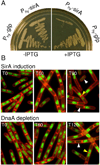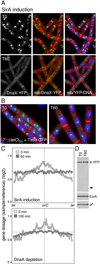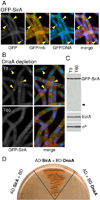SirA enforces diploidy by inhibiting the replication initiator DnaA during spore formation in Bacillus subtilis
- PMID: 19682252
- PMCID: PMC2992877
- DOI: 10.1111/j.1365-2958.2009.06825.x
SirA enforces diploidy by inhibiting the replication initiator DnaA during spore formation in Bacillus subtilis
Abstract
How cells maintain their ploidy is relevant to cellular development and disease. Here, we investigate the mechanism by which the bacterium Bacillus subtilis enforces diploidy as it differentiates into a dormant spore. We demonstrate that a sporulation-induced protein SirA (originally annotated YneE) blocks new rounds of replication by targeting the highly conserved replication initiation factor DnaA. We show that SirA interacts with DnaA and displaces it from the replication origin. As a result, expression of SirA during growth rapidly blocks replication and causes cell death in a DnaA-dependent manner. Finally, cells lacking SirA over-replicate during sporulation. These results support a model in which induction of SirA enforces diploidy by inhibiting replication initiation as B. subtilis cells develop into spores.
Figures







Similar articles
-
The DnaA inhibitor SirA acts in the same pathway as Soj (ParA) to facilitate oriC segregation during Bacillus subtilis sporulation.Mol Microbiol. 2016 Nov;102(3):530-544. doi: 10.1111/mmi.13477. Epub 2016 Aug 25. Mol Microbiol. 2016. PMID: 27489185
-
Structure and interactions of the Bacillus subtilis sporulation inhibitor of DNA replication, SirA, with domain I of DnaA.Mol Microbiol. 2014 Sep;93(5):975-91. doi: 10.1111/mmi.12713. Epub 2014 Aug 5. Mol Microbiol. 2014. PMID: 25041308 Free PMC article.
-
The sporulation protein SirA inhibits the binding of DnaA to the origin of replication by contacting a patch of clustered amino acids.J Bacteriol. 2011 Mar;193(6):1302-7. doi: 10.1128/JB.01390-10. Epub 2011 Jan 14. J Bacteriol. 2011. PMID: 21239581 Free PMC article.
-
Cell Death Pathway That Monitors Spore Morphogenesis.Trends Microbiol. 2017 Aug;25(8):637-647. doi: 10.1016/j.tim.2017.03.005. Epub 2017 Apr 10. Trends Microbiol. 2017. PMID: 28408070 Free PMC article. Review.
-
Cell cycle and sporulation in Bacillus subtilis.Curr Opin Microbiol. 1998 Dec;1(6):630-5. doi: 10.1016/s1369-5274(98)80107-0. Curr Opin Microbiol. 1998. PMID: 10066540 Review.
Cited by
-
Regulation of the replication cycle: conserved and diverse regulatory systems for DnaA and oriC.Nat Rev Microbiol. 2010 Mar;8(3):163-70. doi: 10.1038/nrmicro2314. Nat Rev Microbiol. 2010. PMID: 20157337
-
Regulation of growth of the mother cell and chromosome replication during sporulation of Bacillus subtilis.J Bacteriol. 2011 Jun;193(12):3117-26. doi: 10.1128/JB.00204-11. Epub 2011 Apr 8. J Bacteriol. 2011. PMID: 21478340 Free PMC article.
-
The Role of the N-Terminal Domains of Bacterial Initiator DnaA in the Assembly and Regulation of the Bacterial Replication Initiation Complex.Genes (Basel). 2017 May 10;8(5):136. doi: 10.3390/genes8050136. Genes (Basel). 2017. PMID: 28489024 Free PMC article. Review.
-
SirA inhibits the essential DnaA:DnaD interaction to block helicase recruitment during Bacillus subtilis sporulation.Nucleic Acids Res. 2023 May 22;51(9):4302-4321. doi: 10.1093/nar/gkac1060. Nucleic Acids Res. 2023. PMID: 36416272 Free PMC article.
-
The orisome: structure and function.Front Microbiol. 2015 Jun 2;6:545. doi: 10.3389/fmicb.2015.00545. eCollection 2015. Front Microbiol. 2015. PMID: 26082765 Free PMC article. Review.
References
-
- Bastedo DP, Marczynski GT. CtrA response regulator binding to the Caulobacter chromosome replication origin is required during nutrient and antibiotic stress as well as during cell cycle progression. Mol Microbiol. 2009;72:139–154. - PubMed
-
- Ben-Yehuda S, Losick R. Asymmetric cell division in B. subtilis involves a spiral-like intermediate of the cytokinetic protein FtsZ. Cell. 2002;109:257–266. - PubMed
-
- Ben-Yehuda S, Rudner DZ, Losick R. RacA, a bacterial protein that anchors chromosomes to the cell poles. Science. 2003;299:532–536. - PubMed
-
- Berkmen MB, Grossman AD. Subcellular positioning of the origin region of the Bacillus subtilis chromosome is independent of sequences within oriC, the site of replication initiation, and the replication initiator DnaA. Mol Microbiol. 2007;63:150–165. - PubMed
Publication types
MeSH terms
Substances
Grants and funding
LinkOut - more resources
Full Text Sources
Other Literature Sources
Molecular Biology Databases
Research Materials

